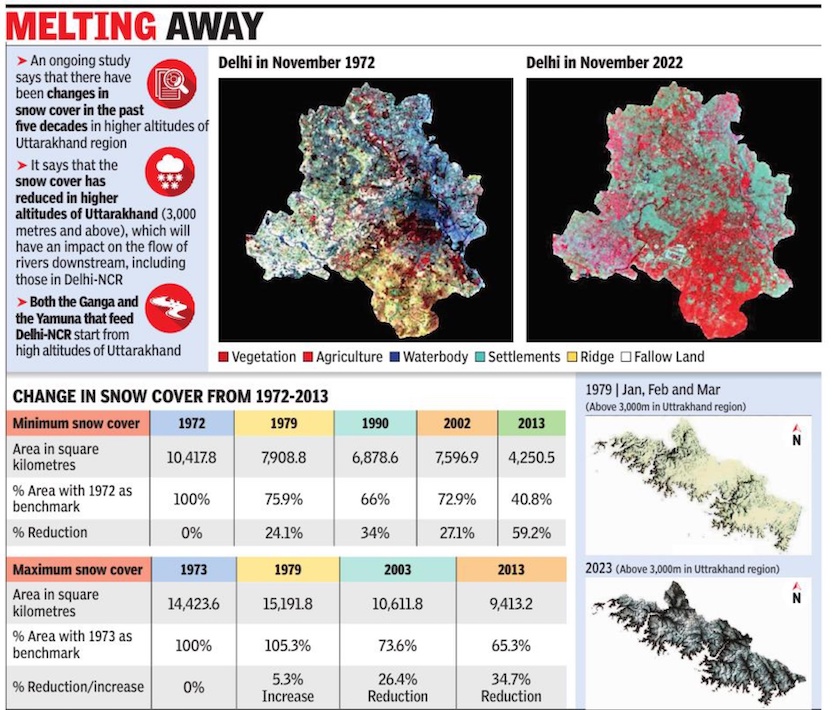Snow cover: India
This is a collection of articles archived for the excellence of their content. |
THE YEAR-WISE STATUS
1972- 2023
Priyangi Agarwal, June 12, 2023: The Times of India

From: Priyangi Agarwal, June 12, 2023: The Times of India
New Delhi: An ongoing study by a research think-tank says that in the past five decades, the snow cover in the higher altitudes of Uttarakhand — 3,000 metres and above — has reduced, which will have an impact on the flow of rivers downstream, including in Delhi-NCR.
A previous study, High Altitude Phytodiversity and Impacts of Climate Variability at Ecosystem and Species Level in Garhwal Himalaya (Uttarakhand) using Geospatial Techniques, funded by the central science and technology department, was based on the decadal data from 1972 to 2013 using Landsat satellite images. The ongoing study, in continuation of the previous one, is capturing the intra annual variability in snow and vegetation covers from 1972 to 2023 and its impact on National Capital Region.
Yogita Shukla, founder and CEO of think-tank addGEO Foundation who shared the initial findings of her research at the 10th edition of ‘dialogue to develop a vision for the environment of Delhi-2025’, said on Monday, “Nature is connected and what happens upstream, it impacts downstream. Any climatic disturbance happening in high altitude will impact DelhiNCR as the aerial distance is not much between them. Both the Ganga and the Yamuna that feed NCR start from the high altitude of Uttarakhand. Hence, any impact on snow cover will have an impact on the flow of rivers downstream. ” The study states that the maximum snow cover in the higher altitude of Uttarakhand region was 14,423. 6 square kilometres in 1973, but it saw a reduction of 34. 7% in 2013 at 9,413. 2 sqkm. Similarly, the minimum snow cover saw a reduction of 59. 3% as the area decreased from 10,417. 8 sqkm in 1973 to 4,250. 5 in 2013. “These observations are taken at a point in one decade, and there have been intermittent increases in snow cover in some years in between. However, the overall trend is drastic reduction in snow cover,” said Shukla.
The weather pattern, she said, has become erratic in Delhi-NCR. “We used to have a cycle of seasons like two-three months each for monsoon and winter. However, winter has now become short and inten- se. We now witness summer with high temperatures, leading to local convection causing rain. This summer, rain also happened due to western disturbances and moisture from Arabian Sea,” said Shukla. Climate change is causing extreme events and high inter annual variability, she added.
According to the study, the decrease in the minimum snow cover over from 1972 to 2013 has resulted in the appearance of certain vegetation types in very high altitude areas that had remained under the snow for several decades. “Since 1990, the disappearance of snow provided good conditions for vegetation underneath to bloom in full growth and has led to the spread of alpine and sub-alpine vegetation earlier covered under the snow,” it says.